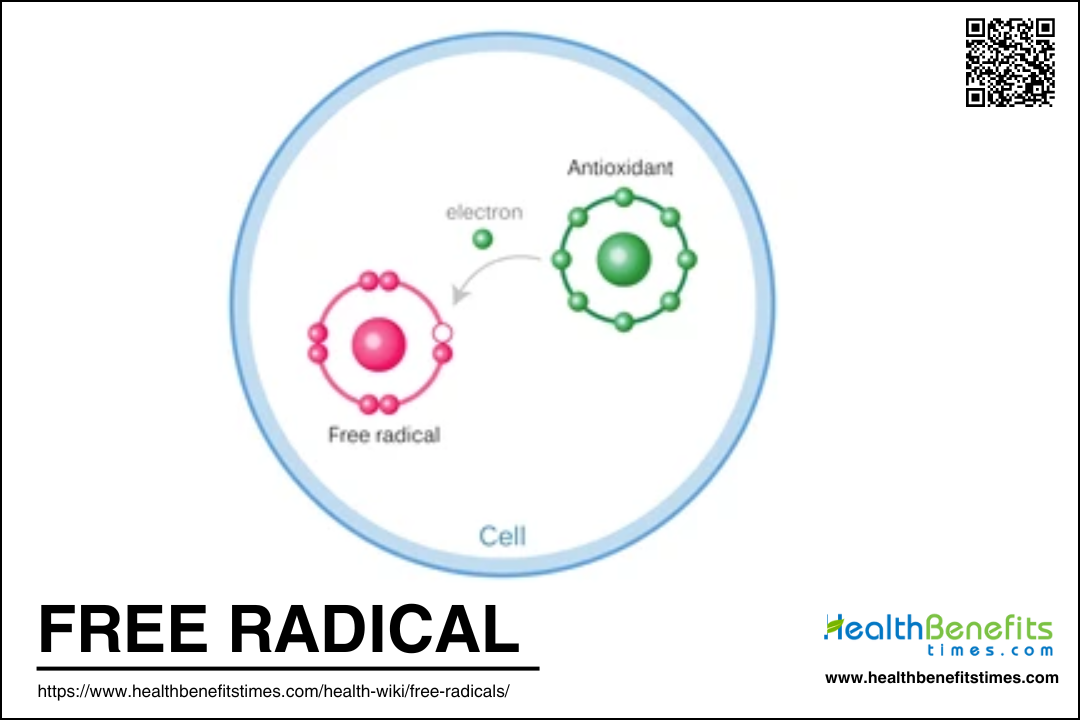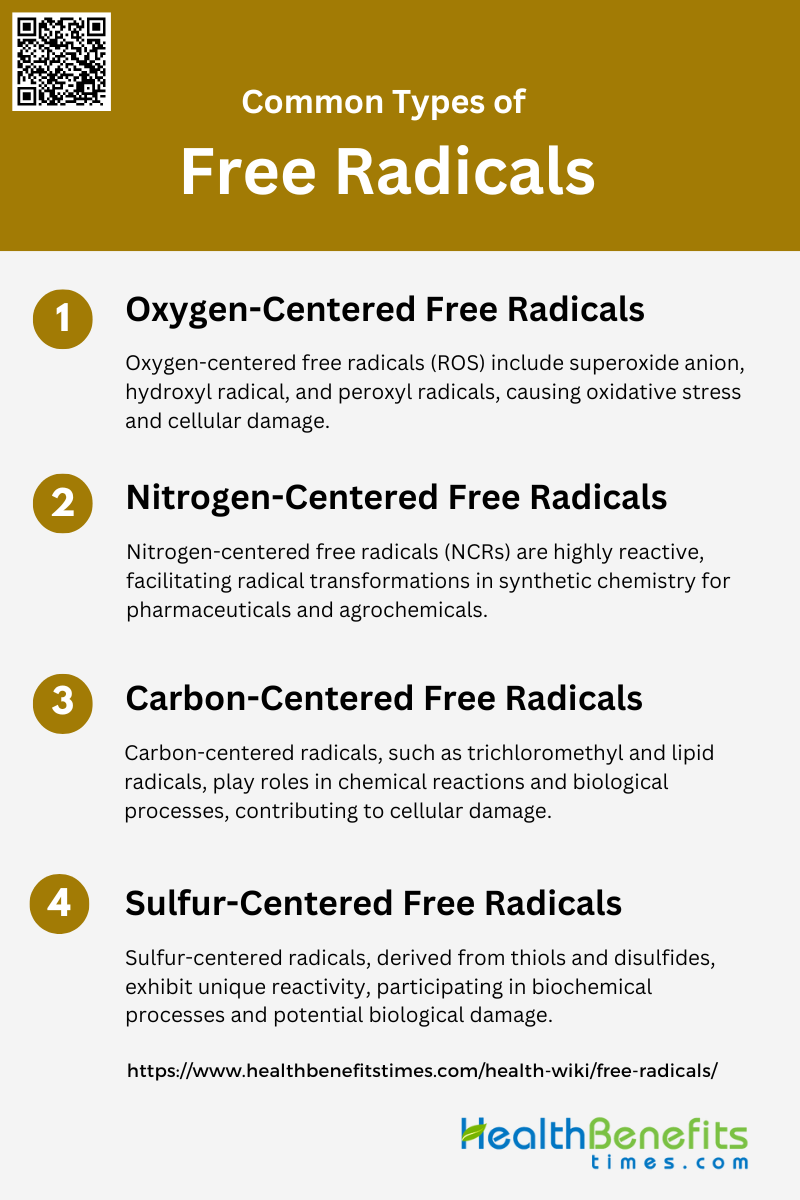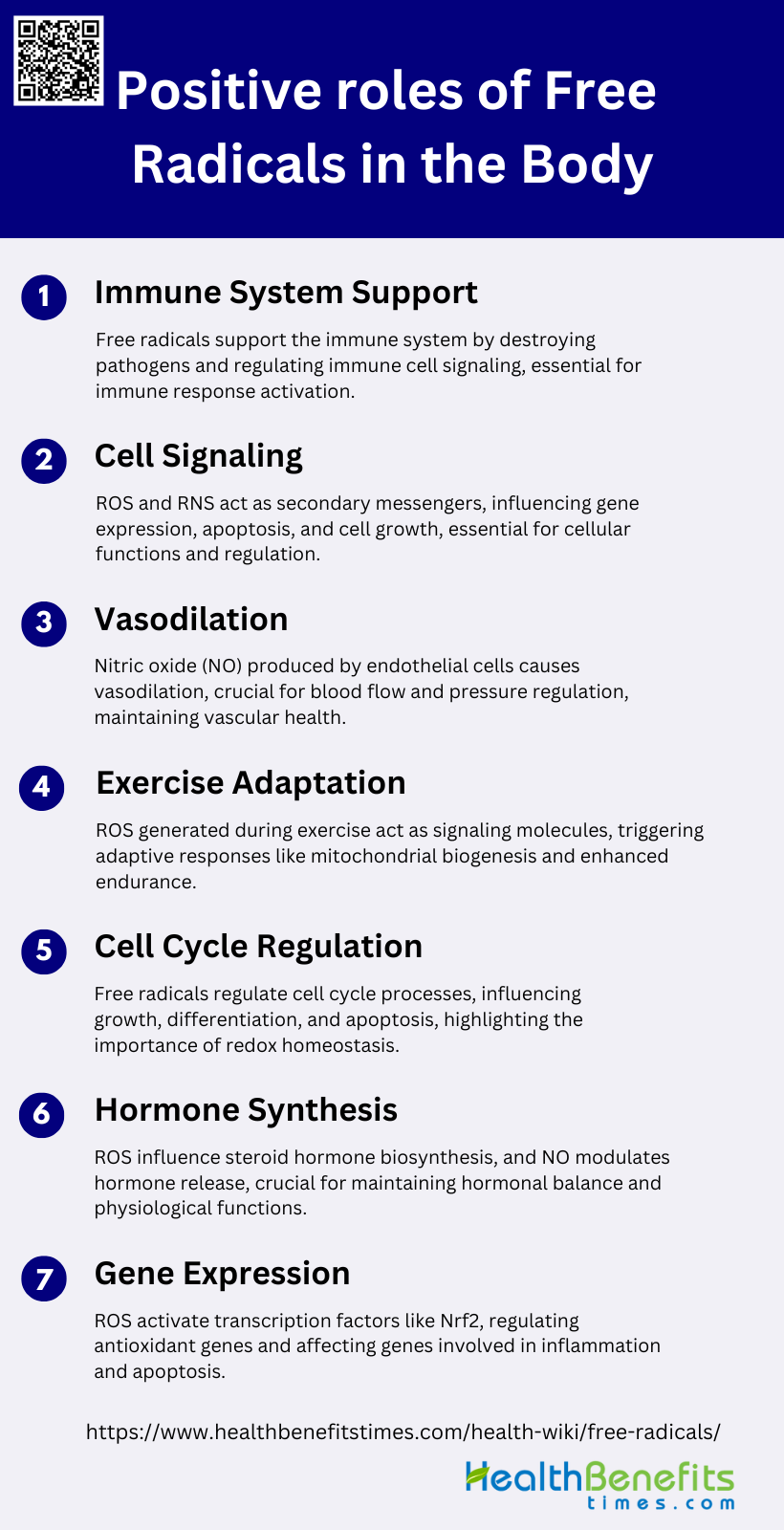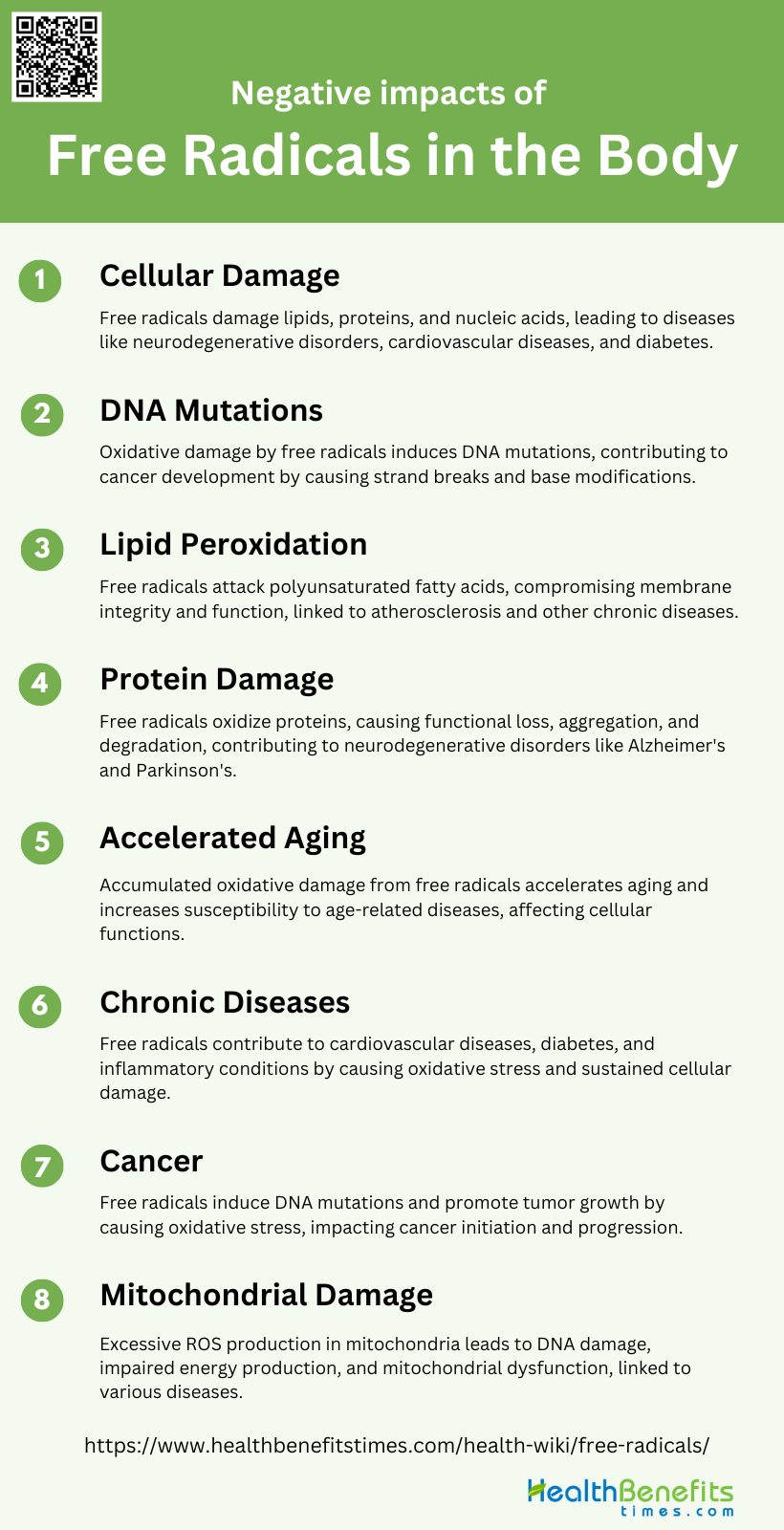Free radicals are highly reactive chemical species that contain one or more unpaired electrons in their outer orbitals, making them unstable and prone to interact with other molecules. These radicals can be produced as by-products of normal metabolic processes or through external factors such as ionizing radiation. While they are often associated with causing oxidative damage to cellular components, leading to diseases like cancer and cardiovascular disorders, free radicals also play crucial roles in physiological processes. For instance, they are involved in cell signaling and the regulation of vascular tone. The body has developed antioxidant defenses to mitigate the harmful effects of free radicals, but an imbalance can lead to tissue injury and various pathologies.
Common types of free radicals
Free radicals are highly reactive molecules that can cause damage to cells, proteins, and DNA by stealing their electrons through a process called oxidation. These molecules are typically unstable and are generated in the body during metabolic processes or through exposure to environmental factors such as pollution, radiation, and cigarette smoke. Below are some of the most common types of free radicals:
1. Oxygen-Centered Free Radicals
Oxygen-centered free radicals, commonly referred to as reactive oxygen species (ROS), are highly reactive molecules containing oxygen. These radicals include superoxide anion (O2•−), hydroxyl radical (•OH), and peroxyl radicals (ROO•). They are primarily generated during cellular metabolic processes, particularly in the mitochondria. ROS can react with lipids, proteins, and DNA, leading to oxidative stress and cellular damage. This oxidative damage is implicated in various diseases, including atherosclerosis, cancer, and neurodegenerative disorders. Despite their potential for harm, ROS also play essential roles in cell signaling and homeostasis, highlighting their dual nature in biological systems.
2. Nitrogen-Centered Free Radicals
Nitrogen-centered free radicals (NCRs) are versatile and highly reactive species that have significant applications in synthetic chemistry. These radicals, such as aminyl, amidyl, and iminyl radicals, can act as electrophiles or nucleophiles, facilitating various radical transformations. NCRs are generated through methods like photoredox catalysis, which allows for controlled radical formation under mild conditions. These radicals are used in the functionalization of sp2 systems, enabling the synthesis of complex nitrogen-containing compounds, including pharmaceuticals and agrochemicals. Despite their potential, the use of NCRs in synthesis is still underexplored compared to carbon-centered radicals.
3. Carbon-Centered Free Radicals
Carbon-centered free radicals are a well-studied class of radicals in organic chemistry, known for their role in various chemical reactions and biological processes. These radicals, such as trichloromethyl (CCl3•) and lipid radicals (L•), are often generated during the metabolism of compounds like carbon tetrachloride (CCl4). In biological systems, carbon-centered radicals can initiate lipid peroxidation, leading to cellular damage and contributing to liver injury and other pathologies. Their reactivity and ability to form stable intermediates make them valuable in synthetic applications, including polymerization and the synthesis of complex organic molecules.
4. Sulfur-Centered Free Radicals
Sulfur-centered free radicals are less commonly discussed but are equally important in both chemical and biological contexts. These radicals, derived from thiols, disulfides, and monosulfides, exhibit unique reactivity due to the specific electronic structures of sulfur atoms. Techniques like pulse radiolysis have been instrumental in studying these radicals, revealing their tendency to coordinate with electron-rich centers and participate in thermodynamic equilibria. Sulfur-centered radicals are involved in various biochemical processes, including the repair and protection mechanisms of thiols, and can contribute to biological damage under certain conditions. Their diverse chemical reactions and potential for forming complex structures make them a significant area of study.
Formation of Free Radicals
Free radicals are formed through various processes within the body and the environment, leading to highly reactive and unstable molecules. These processes include metabolic activities, exposure to pollutants, radiation, and certain chemicals. Below are some of the primary sources and mechanisms of free radical formation:
1. Natural Biological Processes
Free radicals are continuously produced in biological systems as a byproduct of normal metabolic processes. During cellular respiration, reactive oxygen species (ROS) such as superoxide anion radicals and hydrogen peroxide are generated through oxidation-reduction reactions within the mitochondria. These radicals can further react to form highly reactive hydroxyl radicals, which can damage cellular components like nucleic acids, proteins, and lipids. Despite their potential for harm, free radicals also play essential roles in cell signaling and homeostasis. For instance, nitric oxide (NO) and other ROS are involved in regulating vascular tone, oxygen sensing, and signal transduction. The body has evolved mechanisms to mitigate the damage caused by free radicals, including the production of antioxidants such as superoxide dismutase and glutathione peroxidase.
2. External Sources
Free radicals can also be introduced into the body from various external sources, significantly contributing to oxidative stress and tissue damage. Environmental pollutants, ionizing radiation, and cigarette smoke are prominent exogenous sources of free radicals. For example, pollutants like nitrogen dioxide and ozone can generate free radicals that lead to oxidative damage in biological systems. Similarly, exposure to ionizing radiation can produce free radicals that damage cellular DNA and other macromolecules. Smoking introduces a plethora of free radicals and reactive species into the body, exacerbating oxidative stress and contributing to diseases such as cancer, cardiovascular diseases, and respiratory disorders. The harmful effects of these external sources underscore the importance of antioxidants, both endogenous and dietary, in neutralizing free radicals and protecting against oxidative damage.
Positive roles of Free Radicals in the Body
Free radicals play crucial roles in various physiological processes within the body. They are involved in cellular signaling, immune responses, and the regulation of biological pathways. Understanding these positive roles can provide a more balanced perspective on their impact on health.
1. Immune System Support
Free radicals play a crucial role in the immune system by acting as signaling molecules that help in the defense against pathogens. Reactive oxygen species (ROS) and reactive nitrogen species (RNS) are produced by immune cells such as macrophages and neutrophils during the respiratory burst, a rapid release of reactive species used to destroy invading microorganisms. This process is essential for the effective functioning of the immune response. Additionally, free radicals help in the regulation of immune cell signaling pathways, which are vital for the activation and proliferation of immune cells.
2. Cell Signaling
Free radicals, particularly ROS and RNS, are integral to cell signaling processes. They act as secondary messengers in various signaling pathways, influencing gene expression, apoptosis, cell growth, and other cellular functions. For instance, nitric oxide (NO) and superoxide anion are involved in the regulation of vascular tone and signal transduction from membrane receptors. These radicals are generated by tightly regulated enzymes such as NO synthase (NOS) and NAD(P)H oxidase isoforms, ensuring precise control over their signaling roles.
3. Vasodilation
Free radicals, especially nitric oxide (NO), play a significant role in vasodilation, the widening of blood vessels. NO is produced by endothelial cells and diffuses into the surrounding smooth muscle cells, causing relaxation and thus vasodilation. This process is crucial for regulating blood flow and blood pressure. The balance between free radical production and antioxidant defenses is essential for maintaining vascular health, as excessive free radicals can lead to oxidative stress and vascular dysfunction.
4. Exercise Adaptation
During exercise, free radicals are generated in muscles and other tissues. These radicals, particularly ROS, act as signaling molecules that trigger adaptive responses such as mitochondrial biogenesis, increased muscle blood supply, and altered fuel consumption patterns. Moderate levels of ROS are beneficial for exercise adaptation, enhancing endurance and performance. However, excessive free radical production during extreme exercise can overwhelm antioxidant defenses and cause tissue damage, necessitating a balance for optimal adaptation.
5. Cell Cycle Regulation
Free radicals are involved in the regulation of the cell cycle, influencing processes such as cell growth, differentiation, and apoptosis. ROS and RNS can modulate the activity of various cell cycle regulators and signaling pathways. For example, they can induce cell cycle arrest or promote cell proliferation depending on their concentration and the cellular context. This dual role highlights the importance of maintaining redox homeostasis for proper cell cycle regulation and preventing diseases such as cancer.
6. Hormone Synthesis
Free radicals are also involved in the synthesis of hormones. For instance, ROS play a role in the biosynthesis of steroid hormones by influencing the activity of enzymes involved in the steroidogenic pathway. Additionally, nitric oxide (NO) is known to modulate the release of hormones such as insulin and growth hormone. The precise regulation of free radical levels is crucial for maintaining hormonal balance and ensuring proper physiological functions.
7. Gene Expression
Free radicals can influence gene expression by modulating the activity of transcription factors and signaling pathways. For example, ROS can activate the transcription factor Nrf2, which regulates the expression of antioxidant and protective genes. This mechanism helps cells adapt to oxidative stress and maintain redox homeostasis. Additionally, free radicals can affect the expression of genes involved in inflammation, apoptosis, and other cellular processes, highlighting their role in gene regulation.
Negative impacts of Free Radicals in the Body
Free radicals are unstable molecules that can cause significant damage to cells, leading to various health issues. These reactive species are known to contribute to aging, cancer, and other chronic diseases. Understanding their negative impacts in the body is:
1. Cellular Damage
Free radicals, particularly reactive oxygen species (ROS) and reactive nitrogen species (RNS), are highly reactive molecules that can cause significant cellular damage. These molecules can react with various cellular components, including lipids, proteins, and nucleic acids, leading to structural and functional impairments. For instance, ROS can induce oxidative stress, which disrupts cellular homeostasis and damages cellular constituents. The damage caused by free radicals is implicated in the pathogenesis of numerous diseases, including neurodegenerative disorders, cardiovascular diseases, and diabetes. The body’s antioxidant defense mechanisms, although effective, are not always sufficient to counteract the damage caused by excessive free radical production.
2. DNA Mutations
Free radicals can induce mutations in DNA by causing oxidative damage to nucleotides, leading to strand breaks and base modifications. This oxidative DNA damage is a critical step in carcinogenesis, as it can result in the initiation and progression of cancer. The presence of oxidative DNA lesions, such as 8-hydroxydeoxyguanosine (8-OH-G), has been noted in various tumors, strongly implicating free radicals in cancer development. Additionally, DNA damage caused by free radicals can lead to defective repair mechanisms, further increasing the risk of mutations and cancer.
3. Lipid Peroxidation
Lipid peroxidation is a process where free radicals attack polyunsaturated fatty acids in cellular membranes, leading to the formation of lipid peroxides. This process compromises membrane integrity and function, resulting in cellular dysfunction and death. Lipid peroxidation products, such as malondialdehyde, can further react with other cellular components, exacerbating the damage. This oxidative damage to lipids is associated with the development of atherosclerosis and other chronic diseases.
4. Protein Damage
Free radicals can also cause significant damage to proteins by oxidizing amino acid residues, leading to the formation of protein carbonyls and other oxidative modifications. This protein oxidation can result in the loss of protein function, aggregation, and degradation. The accumulation of damaged proteins is linked to various diseases, including neurodegenerative disorders like Alzheimer’s and Parkinson’s disease. Antioxidant defense systems, including enzymatic and non-enzymatic antioxidants, play a crucial role in mitigating protein damage.
5. Accelerated Aging
The free radical theory of aging posits that the accumulation of oxidative damage over time contributes to the aging process. Free radicals can damage cellular components, leading to functional impairments and increased susceptibility to age-related diseases. Oxidative stress is a significant factor in the aging of the brain, where it contributes to neurodegenerative diseases and cognitive decline. The body’s response to oxidative stress includes the induction of protective genes, such as heme oxygenase, which help mitigate the damage.
6. Chronic Diseases
Free radicals are implicated in the development and progression of various chronic diseases, including cardiovascular diseases, diabetes, and inflammatory conditions. Oxidative stress, resulting from an imbalance between free radical production and antioxidant defenses, plays a central role in these diseases. For example, oxidative damage to lipids and proteins can contribute to the pathogenesis of atherosclerosis and rheumatoid arthritis. The chronic nature of these diseases is often associated with sustained oxidative stress and ongoing cellular damage.
7. Cancer
The role of free radicals in cancer is well-documented, with oxidative stress being a key factor in the initiation and progression of the disease. Free radicals can induce DNA mutations, promote cellular proliferation, and inhibit apoptosis, all of which contribute to carcinogenesis. The redox imbalance in cancer cells is often linked to altered signaling pathways that support tumor growth and survival. Antioxidants play a dual role in cancer, as they can both prevent and promote tumorigenesis depending on the context.
8. Mitochondrial Damage
Mitochondria are a significant source of free radicals, particularly during oxidative phosphorylation. Excessive production of ROS in mitochondria can lead to mitochondrial DNA damage, impaired energy production, and the release of pro-apoptotic factors. Mitochondrial dysfunction is associated with various diseases, including neurodegenerative disorders and metabolic syndromes. The damage to mitochondrial components exacerbates cellular oxidative stress, creating a vicious cycle of damage and dysfunction.
Factors That Increase Free Radical Production
Free radicals are unstable molecules that can cause cellular damage and contribute to various diseases. Several factors can increase the production of free radicals in the body. These factors can be broadly categorized into lifestyle, environmental, metabolic, medical, aging, dietary, and physiological processes.
1. Lifestyle Factors
Lifestyle choices significantly influence the production of free radicals. Habits such as cigarette smoking and alcohol consumption are known to elevate oxidative stress, leading to increased free radical formation. Additionally, poor dietary habits, including the consumption of processed foods and low intake of antioxidants, contribute to oxidative damage. Regular physical exercise, while generally beneficial, can also temporarily increase free radical production due to heightened metabolic activity. However, moderate exercise can enhance the body’s antioxidant defenses over time.
2. Environmental Factors
Environmental factors play a crucial role in the generation of free radicals. Exposure to pollutants, such as heavy metals and industrial chemicals, can lead to oxidative stress. Ultraviolet (UV) radiation from the sun and ionizing radiation from medical imaging or nuclear sources also contribute to the formation of reactive oxygen species (ROS). Additionally, environmental stressors like extreme temperatures and high oxygen levels can induce oxidative damage in cells.
3. Metabolic Factors
Metabolic processes within the body are a primary source of free radicals. Mitochondria, the energy-producing organelles in cells, generate ROS as by-products of oxidative phosphorylation. This mitochondrial ROS production is a significant contributor to cellular oxidative stress. Furthermore, metabolic conditions such as obesity and diabetes are associated with increased free radical production due to impaired glucose and lipid metabolism, which exacerbates oxidative damage.
4. Medical Conditions
Various medical conditions are linked to elevated free radical production. Chronic diseases such as cardiovascular disease, neurodegenerative disorders, and rheumatoid arthritis involve oxidative stress as a key pathological mechanism. In these conditions, the imbalance between free radical generation and antioxidant defenses leads to cellular damage. For instance, in diabetes, hyperglycemia induces oxidative stress, contributing to complications like neuropathy and retinopathy.
5. Aging
Aging is inherently associated with increased free radical production. Over time, the efficiency of the body’s antioxidant systems declines, leading to an accumulation of oxidative damage. This age-related oxidative stress is implicated in the pathogenesis of various age-related diseases, including Alzheimer’s disease and Parkinson’s disease. The free radical theory of aging suggests that the progressive increase in oxidative damage is a major determinant of lifespan and age-related functional decline.
6. Dietary Factors
Dietary intake significantly affects free radical production. Diets high in saturated fats and sugars can promote oxidative stress, while diets rich in antioxidants, such as fruits and vegetables, can mitigate it. Antioxidants like vitamins C and E, and polyphenols found in plant-based foods, help neutralize free radicals and protect against oxidative damage. Conversely, deficiencies in essential nutrients can impair the body’s ability to counteract oxidative stress.
7. Physiological Processes
Normal physiological processes, including immune responses and cellular respiration, naturally produce free radicals. During immune responses, phagocytic cells generate ROS to destroy pathogens, which can also cause collateral damage to host tissues. Additionally, processes like apoptosis (programmed cell death) and cellular signaling involve controlled production of free radicals. While these processes are essential for maintaining homeostasis, dysregulation can lead to excessive free radical production and oxidative stress.
How to Reduce Free Radical Damage
Reducing free radical damage is essential for maintaining overall health and preventing chronic diseases. This can be achieved through various strategies that focus on lifestyle changes, dietary adjustments, and environmental awareness. Below are some effective methods to minimize free radical damage:
1. Diet and Nutrition
A balanced diet rich in fruits, vegetables, and whole grains can significantly reduce free radical damage. Nutritional interventions, such as increasing the intake of cruciferous vegetables and spices, have been associated with a reduced incidence of cancer and neurodegenerative diseases. These foods contain antioxidants that counteract the toxic production of reactive oxygen and nitrogen species, thereby protecting against oxidative stress and related diseases.
2. Increase Antioxidant Intake
Antioxidants play a crucial role in scavenging free radicals and minimizing oxidative damage. Vitamins C, E, and beta-carotene, along with trace elements like selenium and zinc, have been shown to reduce oxidative stress and prevent chronic diseases such as cancer and cardiovascular diseases. Supplementation with these antioxidants has also been linked to reduced DNA damage and improved overall health.
3. Avoid Processed and Fried Foods
Processed and fried foods often contain high levels of polyunsaturated fats, which can increase the level of free radical reactions and oxidative stress. Minimizing the intake of these foods can help reduce lipid peroxidation and the associated risk of chronic diseases. Instead, opting for a diet low in unhealthy fats and rich in antioxidants can provide protective benefits.
4. Supplements
Antioxidant supplements, such as vitamins C, E, and beta-carotene, can help reduce oxidative DNA damage and enhance the body’s natural defense mechanisms. These supplements have been shown to decrease the incidence of certain cancers and improve resistance to oxidative stress. However, it is essential to use them cautiously, as excessive supplementation can have adverse effects.
5. Regular Exercise
Engaging in regular physical activity can enhance the body’s antioxidant defense system and reduce oxidative stress. Exercise promotes the production of endogenous antioxidants and improves overall health. However, it is important to balance exercise intensity and duration to avoid excessive oxidative stress.
6. Avoiding Toxins
Exposure to environmental toxins, such as tobacco smoke and air pollutants, can significantly increase free radical production and oxidative damage. Avoiding these toxins and maintaining a clean environment can help reduce the risk of chronic diseases associated with oxidative stress.
7. Meditation
Meditation and other stress-reducing practices can lower oxidative stress by reducing the production of stress hormones that contribute to free radical generation. Incorporating mindfulness and relaxation techniques into daily routines can improve overall well-being and reduce oxidative damage.
8. Adequate Sleep
Getting sufficient sleep is essential for maintaining the body’s antioxidant defense system. Sleep deprivation can increase oxidative stress and weaken the immune system. Ensuring adequate and quality sleep can help the body repair and regenerate, reducing the impact of free radicals.
9. Stress Management
Chronic stress can lead to increased production of free radicals and oxidative stress. Effective stress management techniques, such as yoga, meditation, and regular physical activity, can help mitigate these effects and improve overall health.
10. Avoid Smoking and Limit Alcohol
Smoking and excessive alcohol consumption is significant sources of free radicals and oxidative stress. Quitting smoking and limiting alcohol intake can reduce the risk of oxidative damage and associated chronic diseases. Adopting a healthy lifestyle with minimal exposure to these substances is crucial for reducing free radical damage.
11. Minimize Exposure to Pollutants
Reducing exposure to environmental pollutants, such as heavy metals and industrial chemicals, can help decrease oxidative stress. Using air purifiers, avoiding heavily polluted areas, and consuming organic foods can minimize the intake of harmful substances that contribute to free radical production.
12. Use Sunscreen
Ultraviolet (UV) radiation from the sun can generate free radicals and cause oxidative damage to the skin. Using sunscreen with a high SPF can protect the skin from UV-induced oxidative stress and reduce the risk of skin cancer and premature aging.
13. Avoid Unnecessary Radiation
Limiting exposure to unnecessary radiation, such as from medical imaging and electronic devices, can help reduce oxidative stress. Taking protective measures, such as using lead aprons during X-rays and minimizing the use of electronic devices can lower the risk of radiation-induced free radical damage.
Common Myths and Misconceptions
There are numerous myths and misconceptions surrounding various topics, often leading to misinformation and confusion. Understanding the truth behind these myths is crucial for making informed decisions. Below are some common myths and misconceptions debunked:
1. Myth: All free radicals are harmful
Contrary to the common belief that all free radicals are harmful, they actually play a dual role in the body. While it is true that free radicals can cause cellular damage, leading to diseases such as cancer, atherosclerosis, and neurodegenerative disorders, they also have beneficial roles. Free radicals are involved in essential physiological processes, including cell signaling and immune responses. For instance, they help in the destruction of pathogens by immune cells. Therefore, the body maintains a balance between free radicals and antioxidants to harness their beneficial effects while minimizing potential harm.
2. Myth: Antioxidant supplements can replace a healthy diet
The notion that antioxidant supplements can replace a healthy diet is a misconception. While supplements can provide specific antioxidants, they do not offer the complex mix of nutrients found in whole foods. Whole foods contain antioxidants in natural ratios and proportions, which may act synergistically to optimize health benefits. Moreover, excessive intake of antioxidant supplements can have detrimental effects, potentially disrupting the body’s natural oxidative balance and leading to adverse health outcomes. Therefore, a varied and balanced diet remains the best approach to maintain optimal antioxidant status and overall health.
3. Myth: More antioxidants always mean better health
The idea that more antioxidants always lead to better health is misleading. Although antioxidants are crucial in neutralizing free radicals and preventing oxidative stress, an excess of antioxidants can be harmful. High doses of antioxidant supplements can interfere with the body’s natural defense mechanisms and may even act as pro-oxidants under certain conditions. Clinical trials have shown inconsistent results regarding the efficacy of high-dose antioxidant supplements in disease prevention. Therefore, it is essential to maintain a balanced intake of antioxidants through a healthy diet rather than relying on high-dose supplements.







